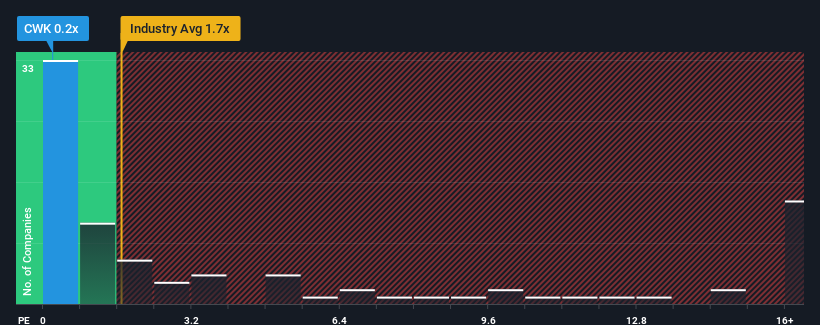Benign Growth For Cushman & Wakefield plc (NYSE:CWK) Underpins Stock's 27% Plummet
To the annoyance of some shareholders, Cushman & Wakefield plc (NYSE:CWK) shares are down a considerable 27% in the last month, which continues a horrid run for the company. The drop over the last 30 days has capped off a tough year for shareholders, with the share price down 23% in that time.
Although its price has dipped substantially, Cushman & Wakefield may still be sending buy signals at present with its price-to-sales (or "P/S") ratio of 0.2x, considering almost half of all companies in the Real Estate industry in the United States have P/S ratios greater than 1.7x and even P/S higher than 10x aren't out of the ordinary. However, the P/S might be low for a reason and it requires further investigation to determine if it's justified.
View our latest analysis for Cushman & Wakefield

What Does Cushman & Wakefield's P/S Mean For Shareholders?
While the industry has experienced revenue growth lately, Cushman & Wakefield's revenue has gone into reverse gear, which is not great. The P/S ratio is probably low because investors think this poor revenue performance isn't going to get any better. So while you could say the stock is cheap, investors will be looking for improvement before they see it as good value.
If you'd like to see what analysts are forecasting going forward, you should check out our free report on Cushman & Wakefield .How Is Cushman & Wakefield's Revenue Growth Trending?
The only time you'd be truly comfortable seeing a P/S as low as Cushman & Wakefield's is when the company's growth is on track to lag the industry.
Retrospectively, the last year delivered virtually the same number to the company's top line as the year before. That's essentially a continuation of what we've seen over the last three years, as its revenue growth has been virtually non-existent for that entire period. Accordingly, shareholders probably wouldn't have been satisfied with the complete absence of medium-term growth.
Shifting to the future, estimates from the eight analysts covering the company suggest revenue should grow by 5.5% per annum over the next three years. That's shaping up to be materially lower than the 13% each year growth forecast for the broader industry.
With this in consideration, its clear as to why Cushman & Wakefield's P/S is falling short industry peers. Apparently many shareholders weren't comfortable holding on while the company is potentially eyeing a less prosperous future.
The Final Word
The southerly movements of Cushman & Wakefield's shares means its P/S is now sitting at a pretty low level. Using the price-to-sales ratio alone to determine if you should sell your stock isn't sensible, however it can be a practical guide to the company's future prospects.
As expected, our analysis of Cushman & Wakefield's analyst forecasts confirms that the company's underwhelming revenue outlook is a major contributor to its low P/S. Shareholders' pessimism on the revenue prospects for the company seems to be the main contributor to the depressed P/S. Unless these conditions improve, they will continue to form a barrier for the share price around these levels.
And what about other risks? Every company has them, and we've spotted 1 warning sign for Cushman & Wakefield you should know about.
If you're unsure about the strength of Cushman & Wakefield's business, why not explore our interactive list of stocks with solid business fundamentals for some other companies you may have missed.
Have feedback on this article? Concerned about the content? Get in touch with us directly. Alternatively, email editorial-team (at) simplywallst.com.
This article by Simply Wall St is general in nature. We provide commentary based on historical data and analyst forecasts only using an unbiased methodology and our articles are not intended to be financial advice. It does not constitute a recommendation to buy or sell any stock, and does not take account of your objectives, or your financial situation. We aim to bring you long-term focused analysis driven by fundamental data. Note that our analysis may not factor in the latest price-sensitive company announcements or qualitative material. Simply Wall St has no position in any stocks mentioned.
 Wall Street Journal
Wall Street Journal